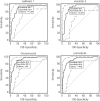Two-dimensional differential in-gel electrophoresis proteomic approaches reveal urine candidate biomarkers in pediatric obstructive sleep apnea
- PMID: 19797158
- PMCID: PMC2796735
- DOI: 10.1164/rccm.200905-0765OC
Two-dimensional differential in-gel electrophoresis proteomic approaches reveal urine candidate biomarkers in pediatric obstructive sleep apnea
Abstract
Rationale: Sleep studies are laborious, expensive, inaccessible, and inconvenient for diagnosing obstructive sleep apnea (OSA) in children.
Objectives: To examine whether the urinary proteome uncovers specific clusters that are differentially expressed in the urine of children with OSA.
Methods: Two-dimensional differential in-gel electrophoresis (2D-DIGE) and mass spectrometry proteomics followed by validation with western blot of ELISA.
Measurements and main results: Morning urine proteins from 60 children with polysomnographically confirmed OSA and from matched children with primary snoring (n = 30) and control subjects (n = 30) were assessed. A total of 16 proteins that are differentially expressed in OSA were identified, and 7 were confirmed by either immunoblots or ELISA. Among the latter, receiver-operator curve analyses of urinary concentrations of uromodulin, urocortin-3, orosomucoid-1, and kallikrein assigned favorable predictive properties to these proteins. Furthermore, combinatorial approaches indicated that the presence of values beyond the calculated cutoff concentrations for three or more of the proteins yielded a sensitivity of 95% and a specificity of 100%.
Conclusions: Proteomic approaches reveal that pediatric OSA is associated with specific and consistent alterations in urinary concentrations of specific protein clusters. Future studies aiming to validate this approach as a screening method of habitually snoring children appears warranted.
Figures






References
-
- O'Brien LM, Mervis CB, Holbrook CR, Bruner JL, Smith NH, McNally N, McClimment MC, Gozal D. Neurobehavioral correlates of sleep-disordered breathing in children. J Sleep Res 2004;13:165–172. - PubMed
-
- Ferreira AM, Clemente V, Gozal D, Gomes A, Pissarra C, César H, Coelho I, Silva CF, Azevedo MHP. Snoring in Portuguese primary school children. Pediatrics 2000;106:E64. - PubMed
Publication types
MeSH terms
Substances
Grants and funding
LinkOut - more resources
Full Text Sources
Other Literature Sources
Medical

